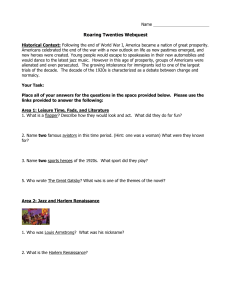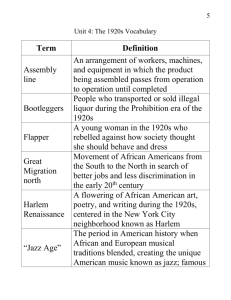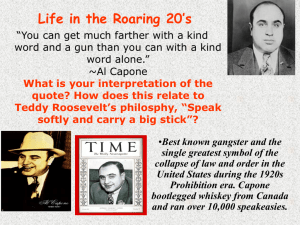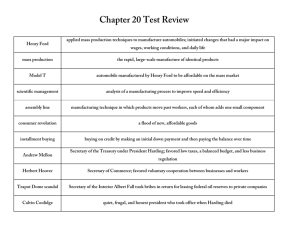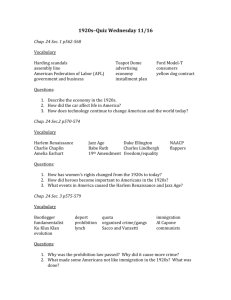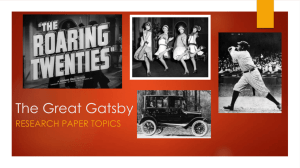Background about the Roaring 1920s PowerPoint
advertisement
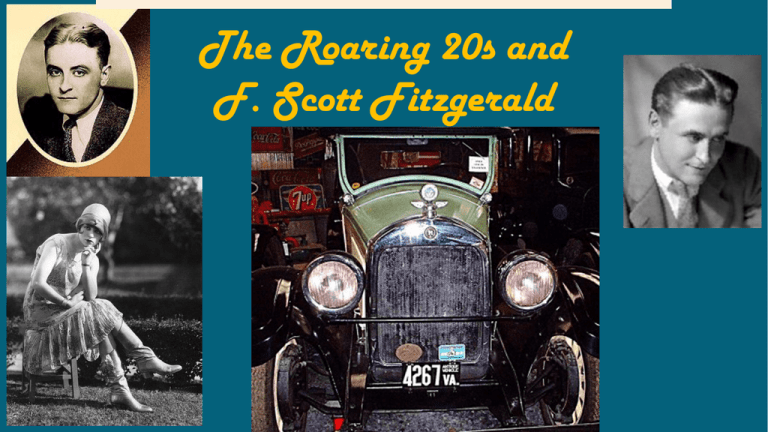
The Roaring 20s and F. Scott Fitzgerald 1920s Period of time after World War 1 - idea of “The Roaring 20s” started in the US spread to Europe. 1920's collectively known as the "Roaring 20's", or the "Jazz Age" in sum, a period of great change in American Society modern America is born at this time for first time the census reflected an urban society people had moved into cities to enjoy a higher standard of living •The spirit of the Roaring Twenties was marked by a feeling associated with a break with tradition. The idea of “modernity” spread rapidly. Modern--- break w/ tradition •Everything seemed to be feasible through modern technology. Post-war Economic boom--- lots of money surge in technology. Credit was widely available so people could live above their means, trusting in continued prosperity to enable them to eventually pay off their debt Ex: cars, trains, radio, telephones, mass communication •For the first time there was such a thing as mass communication and it brought the idea of modernity to the American public. •Radio enabled mass marketing for the first time—its economic importance led to the mass culture that continues to dominate society. •The 20s have also been dubbed “the golden age of radio.” During the 20s mass production developed which allowed for cheaper prices of technology products. This made the automobile affordable, as well as movies and radios. By 1927, Henry Ford had sold 15 million Model T cars. 20s--- “The Jazz Age”--- radios began broadcasting jazz music, which became extremely popular and was associated with all things modern, sophisticated, and decadent. Changing Ways of Life During the 1920s, urbanization continued to accelerate. For the first time, more Americans lived in cities than in rural areas. New York City was home to over 5 million people in 1920. Chicago had nearly 3 million. Urban vs. Rural Throughout Cities were impersonal Farms were friendly the 1920s, Americans found themselves caught between urban and rural cultures. Urban life was considered a world of anonymous crowds, strangers, moneymakers, and pleasure seekers. Rural life was considered to be safe, with close personal ties, hard work, and morals. Age of Prosperity Economic expansion Mass Production Assembly Line Age of the Automobile Ailing Agriculture… an agri. depression in early 1920's contributed to this urban migration U.S. farmers lost agri. markets in postwar Europe at same time agri. efficiency increased so more food produced (more food = lower prices) and fewer labourers needed so farming was no longer as prosperous, and bankers called in their loans (farms repossessed) so American farmers enter the Depression in advance of the rest of society Black Americans in this period continued to live in poverty sharecropping kept them in de facto slavery 1915 - boll weevil wiped out the cotton crop white landowners went bankrupt & forced blacks off their land Blacks moved north to take advantage of booming wartime industry (= Great Migration) - Black ghettoes began to form, i.e. Harlem within these ghettoes a distinct Black culture flourished But both blacks and whites wanted cultural interchange restricted Consumer Economy Prohibition One example of the clash between city & farm was the passage of the 18th Amendment in 1920. This Amendment launched the era known as Prohibition. The new law made it illegal to make, sell or transport liquor. Prohibition lasted from 1920 to 1933 when it was repealed by the 21st Amendment Prohibition Volstead Act 18th Amendment Gangsters Al Capone 18th Amendment Enacted Prohibition through the Volstead Act- the manufacture, sale, import, and export of alcohol in the U.S. was prohibited. This amendment gave rise to organized crime---mob as illegal smuggling became big business for criminal organizations. Support for Prohibition Reformers had long believed alcohol led to crime, child & wife abuse, and accidents. Supporters were largely from the rural south and west. The church affiliated Anti-Saloon League and the Women’s Christian Temperance Union helped push the 18th Amendment through. Poster supporting prohibition PROHIBITION - on manuf. and sale of alcohol adopted in 1919 - 18th AMENDMENT an outgrowth of the longtime temperance movement in WWI, temperance became a patriotic mvmt. - drunkenness caused low productivity & inefficiency, and alcohol needed to treat the wounded a difficult law to enforce... organized crime, speakeasies, bootleggers were on the rise Al Capone virtually controlled Chicago in this period capitalism at its zenith… Prohibition finally ended in 1933 w/ the 21st Amendment forced organized crime to pursue other interests… Speakeasies & Bootleggers Many Americans did not believe drinking was a sin. Most immigrant groups. were not willing to give up drinking. To obtain liquor illegally, drinkers went underground to hidden saloons known as speakeasies. People also bought liquor from bootleggers who smuggled it in from Canada, Cuba and the West Indies. Speakeasies Became popular and numerous as the Prohibition years progressed, and led to the rise of gangsters such as Al Capone. Place to get alcohol Speak the password to get in Corruption- speakeasy operators would bribe police; tipped off operators Organized Crime Al Capone was finally convicted on tax evasion charges in 1931 Prohibition contributed to the growth of organized crime in every major city. Chicago became notorious as the home of Al Capone – a famous bootlegger. Capone took control of the Chicago liquor business by killing off his competition. Government Fails to Control Liquor Eventually, Prohibition’s fate was sealed by the government, which failed to budget enough money to enforce the law. The task of enforcing Prohibition fell to 1,500 poorly paid federal agents --- clearly an impossible task Federal agents pour wine down a sewer Support Declined, Prohibition Repealed By the mid-1920s, only 19% of Americans supported Prohibition. Many felt Prohibition caused more problems than it solved. The 21st Amendment finally repealed Prohibition in 1933. Science and Religion Clashed Another battleground during the 1920s was between fundamentalist religious groups and secular thinkers over the truths of science. The Protestant movement grounded in the literal interpretation of the bible is known as fundamentalism. Fundamentalists found all truth in the bible – including science & evolution. Evolution In March 1925, Tennessee passed the nation’s first law that made it a crime to teach evolution. The ACLU promised to defend any teacher Scopes was a biology teacher who willing to challenge the dared to teach his students that man law and John Scopes derived from lower species. accepted the challenge. Scopes “Monkey” Evolution vs. Creationism Famous Lawyers Trial Science vs. Religion Dayton, Tennessee John Scopes High School Biology teacher Darrow vs. Bryan The ACLU hired Clarence Darrow, the most famous trial lawyer of the era, to defend Scopes. The prosecution countered with William Jennings Bryan, the three-time Democratic presidential nominee. Darrow Bryan The Scopes Trial The trial opened on July 10,1925, and became a national sensation. In an unusual move, Darrow called Bryan to the stand as an expert on the bible – key question: Should the bible be interpreted literally? Under intense questioning, Darrow got Bryan to admit that the bible can be interpreted in different ways. Nevertheless, Scopes was found guilty and fined $100. Despite the guilty verdict, Darrow got the upper hand during his questioning of Bryan. The Twenties Woman Chicago 1926 After the tumult of World War I, Americans were looking for a little fun in the 1920s. Women were becoming more independent and achieving greater freedoms (the right to vote, greater employment, and the freedom of the auto) 1920's also brought about great changes for women... 1920 - 19th Amendment gave them the federal vote after 1920, social circumstances changed too as more women worked outside the home and more women went to college and clamoured to join the professions women didn't want to sacrifice wartime gains amounted to a social revolt characterized by the FLAPPER/ "new woman" – (bobbed hair, short dresses, smoked in public...) The Flapper A Flapper was an emancipated young woman who embraced the new fashions and urban attitudes. Flappers: as the role of women began to change and more women entered the work force, there was a style move towards androgyny. Corsets went out of style, the bob became the preferred hair style, and some women even taped their breasts to make them look flatter. This style was dubbed “Flapper” –and was marked by women who wore short dresses with a straight, loose silhouette. New Roles for Women Early 20th Century teachers The fast-changing world of the 1920s produced new roles for women. Many women entered the workplace as nurses, teachers, librarians, & secretaries. However, women earned less than men and were kept out of many traditional male jobs (e.g., management) and faced discrimination. The Changing Family Margaret Sanger and other founders of the American Birth Control League - 1921 American birthrates declined for several decades before the 1920s. During the 1920s that trend increased as birth control information became widely available. Birth control clinics opened and the American Birth Control League was founded in 1921. The Modern Family As the 1920s unfolded, many features of the modern family emerged. Marriage was based on romantic love, middle class women managed the household and finances, and children were not considered wage earners but young people who needed nurturing and education. American Heroes In 1929, Americans spent $4.5 billion on entertainment (including sports). People crowded into baseball games to see their heroes. Babe Ruth was a larger than life American hero who played for Yankees. He hit 60 homers in 1927. Lindbergh’s Flight America’s most beloved hero of the 1920s wasn’t an athlete but a small-town pilot named Charles Lindbergh. Lindbergh made the first nonstop solo trans-Atlantic flight. He took off from NYC in the Spirit of St. Louis and arrived in Paris 33 hours later to a hero’s welcome. Entertainment Walt Disney's animated Steamboat Willie marked the debut of Mickey Mouse. It was a seven minute long black and white cartoon. Even before sound, movies offered a means of escape through romance and comedy. The first sound movie was the Jazz Singer (1927) and the first animation with sound was Steamboat Willie (1928). By 1930, millions of Americans went to the movies every week. Music and Art Famed composer George Gershwin merged traditional elements with American jazz. Painters like Edward Hopper depicted the loneliness of American life. Georgia O’ Keeffe captured the grandeur of New York using intensely colored canvases. Gershwin Georgia O'Keeffe Hopper’s famous Nighthawks Louis Armstrong: one of the most notable jazz musicians of the time. Known for improvisations and endless variations on a single melody. Other notable jazz musicians: Ella Fitzgerald and Duke Ellington. Literature The 1920s was one of the greatest literary eras in American history. Sinclair Lewis, the first American to win the Nobel Prize in literature, wrote the novel Babbitt in which the main character ridicules American conformity and materialism Writer F. Scott Fitzgerald coined the phrase “Jazz Age” to describe the 1920s. Fitzgerald wrote Paradise Lost and The Great Gatsby, which reflected the emptiness of New York elite society. Hemingway - 1929 Ernest Hemingway, who was wounded in World War I, became one of the best-known authors of the era. His novels The Sun Also Rises and A Farewell to Arms criticized the glorification of war. His simple, straightforward style of writing set the literary standard of the day. The Lost Generation Some writers (e.g., Hemingway and John Dos Passos) were so disillusioned by American culture that they chose to settle in Europe. In Paris they formed a group that one writer called “The Lost Generation.” John Dos Passos’ self – portrait. He was a good amateur painter. Lost Generation Young people who came out of WWI very cynical and disillusioned; the term usually refers to American literary notables that lived in Paris at the time; examples, Ernest Hemingway, F. Scott Fitzgerald, and Gertrude Stein. The Harlem Renaissance Between 1910 and 1920, the Great Migration saw hundreds of thousands of African Americans move north to big cities. By 1920, over 5 million of the nation’s 12 million blacks (over 40%) lived in cities. Migration of the Negro by Jacob Lawrence African American Goals Founded in 1909, the NAACP urged African Americans to protest racial violence W.E.B Dubois, a founding member, led a march of 10,000 black men in NY to protest violence. Marcus Garvey Marcus Garvey believed that African Americans should build a separate society in Africa. In 1914, he founded the Universal Negro Improvement Association (UNIA) and attracted a million members by the mid-1920s. He left a powerful legacy of black pride, economic independence, and Pan-Africanism. If you have no confidence in self, you are twice defeated in the race of life. With confidence, you have won even before you have started. – M. Garvey Harlem, New York Harlem, NY became the largest black urban community. Harlem suffered from overcrowding, unemployment and poverty. However, in the 1920s, it was home to a literary and artistic revival known as the Harlem Renaissance. African American Writers The Harlem Renaissance included a literary movement led by well-educated blacks with a new sense of pride in the African-American experience. Claude McKay’s works expressed the pain and frustration of life in the ghetto. Missouri-born Langston Hughes was the movement’s best known poet. Many of his poems described the difficult lives of working-class blacks. Some of his poems were put to music, especially jazz and blues. Zora Neale Hurston wrote novels, short stories, and poems. She often wrote about the lives of poor, unschooled, southern blacks. She focused on the culture of the people– their folkways and values. African-American Performers During the 1920s, black performers had large followings. Paul Robeson, son of a slave, became a major dramatic actor. His performance in Othello was widely praised. In the late 1920s, Duke Ellington, a jazz pianist and composer, led his ten-piece orchestra at the famous Cotton Club. Ellington won renown as one of America’s greatest composers. Bessie Smith, blues singer, was perhaps the most outstanding vocalist of the decade. She achieved enormous popularity and by 1927, she became the highest- paid black artist in the world. Oct. 29, 1929: Stock Market crashed which contributed to the start of the Great Depression--Black Tuesday The economic boom of the 20s set the stage for the Great Depression that would dominate the 30s. 21st Amendment--- repealed the 18th Amendment---up to the states to legalized alcohol; Feb. 20 1933 The American Dream: originally about discovery individualism, and the pursuit of happiness. Implies successful and satisfying life, financial security and material comforts. Many authors criticized and satirized the hypocrisy and greed they observed in America’s empty pursuit of wealth and luxury. Thus, the idea that the American dream had become corrupt by the empty pursuit of wealth is a theme that runs through many novels from this time period. Nick Carraway - The novel’s narrator, Nick is a young man from Minnesota who, after being educated at Yale and fighting in World War I, goes to New York City to learn the bond business. Honest, tolerant, and inclined to reserve judgment, Nick often serves as a confidant for those with troubling secrets. Daisy’s cousin. Jay Gatsby - The title character and protagonist of the novel, Gatsby is a fabulously wealthy young man living in a Gothic mansion in West Egg. He is famous for the lavish parties he throws every Saturday night, but no one knows where he comes from, what he does, or how he made his fortune. Daisy Buchanan - Nick’s cousin, and the woman Gatsby loves. Married to Tom Buchanan. Tom Buchanan - Daisy’s immensely wealthy husband, once a member of Nick’s social club at Yale. Powerfully built and hailing from a socially solid old family, Tom is an arrogant, hypocritical bully. Jordan Baker - Daisy’s friend, a woman with whom Nick becomes romantically involved during the course of the novel. A competitive golfer, Jordan represents one of the “new women” of the 1920s—cynical, boyish, and self-centered. Myrtle Wilson - Tom’s lover, whose lifeless husband George owns a run-down garage in the valley of ashes. Myrtle herself possesses a fierce vitality and desperately looks for a way to improve her situation. George Wilson - Myrtle’s husband, the lifeless, exhausted owner of a rundown auto shop at the edge of the valley of ashes. George loves and idealizes Myrtle, and is devastated by her affair with Tom Klipspringer - The shallow freeloader who seems almost to live at Gatsby’s mansion, taking advantage of his host’s money. East Egg: Old Money- where Tom and Daisy live West Egg: New Money- where Gatsby lives Is anyone still writing? Setting for The Great Gatsby: The story takes place outside of New York City- in what is known as Long Island or the Hamptons. However, in the book, they are called East and West Egg. East Egg: People with old money live there- in other words, money that has been inherited through many generations. People from old money do not show off their money. They also have many hidden rules that go with their class. Therefore, if you are not born into old money, you can’t fit in. West Egg: where people from new money live. New money means that you’ve either earned it yourself or it’s only one generation back. These people show off their money- flashy behavior (think Russell Simmons’ gold toilet). They want to fit in with old money, but old money looks down on them.


